The ideal length of a paragraph may vary depending on the purpose of writing. However, we cannot deny the importance of a perfect length of a paragraph to make our writing good, readable, and effective. In this post, I’ll talk about the ideal length of a paragraph, along with the other characteristics of a paragraph.
Generally, the ideal length of a paragraph should be 120 to 200 words consisting of 3 to 4 sentences. An ideal paragraph should have a topic sentence, at least one supporting sentence, and a concluding sentence. However, the length may vary depending on the purpose of writing, the matter you want to explain, and the target readers’ level.
You may try Fifty Ways to Practice Writing: Tips for ESL/EFL Students to practice and improve writing with pen and paper and typing. By applying these methods, you will write more, write faster, and write more correct and more interesting papers and letters.
Chapters
- The Ideal Length of a Paragraph in General-Purpose Writings
- The Ideal Length of a Paragraph in Academic or Business Writings
- The Ideal Length of a Paragraph in Web Contents
- The Ideal Length of a Paragraph in Research Articles
- How Long Should a Topic Sentence of a Paragraph Be?
- 10 Basic Characteristics of an Ideal Paragraph
- What Does an Ideal Paragraph Look Like?
- What Is the Purpose of an Ideal Paragraph?
- Purpose of Paragraphs in Long Piece of Writing
- Can a Single Sentence Make a Paragraph?
- Make a Balance between Paragraphs’ Length in the Same Writing
- Importance of a Well-structured Paragraph
- In Conclusion
The Ideal Length of a Paragraph in General-Purpose Writings
For general-purpose writing, the ideal length of a paragraph is 120 to 200 words. However, the paragraph should not be long whether you write an essay or anything more extended. I recommend keeping such paragraphs within 3 to 4 sentences and 400 to 500 characters.
The paragraphs in general-purpose writing are written for a general audience. This type of writing usually doesn’t have a specific target audience. For example, if I write about the Tajmahal in India on my blog, there is a possibility that different levels of readers will read that.
So, I must maintain an ideal length of my paragraphs in my blog post. If I make it too long, it may affect readability and lead the readers to boredom.
The Ideal Length of a Paragraph in Academic or Business Writings
The paragraphs for academic or business purposes may contain one idea expressed in 150 to 250 Words with 700 to 900 characters. However, the number of words and sentences may vary depending on the topic.
A paragraph in an essay written for academic or business purposes can be slightly longer than those written for general purposes. In addition, as these essays usually deal with serious and complex topics, they may require more explanations and examples in many cases.
Even as the target readers of academic or business writings are usually of an advanced level, lengthy paragraphs don’t affect readability.
The Ideal Length of a Paragraph in Web Contents
The average length of a blog post should be 3 to 4 lines or 300-350 characters, no matter how many sentences it takes. Maintaining such an ideal length is very crucial to ensure readability.
Writing web content, specifically a blog post, requires you to keep several things in mind. As a blog post writer, you would obviously want to keep your article’s readability as your highest priority. Therefore, the paragraphs’ length in a blog post is crucial to ensure the reader’s engagement with your text.
Nowadays, most readers read blogs on their mobile phones. If you don’t keep your paragraphs short, as mentioned above, it will be difficult for mobile users to follow the text. On mobile, a paragraph with more than 4 lines seems like a big paragraph, which may make your audience less interested.
If you make your paragraphs longer for online texts, your readers may need to scroll, though they are still reading a single idea. This may distract them and make their reading experience horrible. Therefore, a quality blog post should not have paragraphs of more than 4 lines.
The Ideal Length of a Paragraph in Research Articles
There should not be any specific word or sentence counts for paragraphs in research articles. The paragraphs in such writing should continue until the idea is explained correctly and left with no ambiguity. However, the best practice is to keep them less than 350 words so the paragraph doesn’t look too stuffy.
Research articles usually deal with the most serious and complex ideas. And the target readers are the learned audience with a very advanced level of reading skills. Therefore, one does not have to be too strict about the length of paragraphs while writing research articles.
As word count is not an issue in paragraphs for research articles, one should maintain a proper structure to ensure readability.
Each Paragraph should start with a topic sentence, sometimes along with a background or problem statement. Then the body should include multiple logically sequenced supporting details. And finally, a concluding sentence must come with a hint of transition to the next paragraph.
How Long Should a Topic Sentence of a Paragraph Be?
A topic sentence is the first sentence of a paragraph that introduces the topic of the paragraph. It should have the length of an ideal sentence depending on the subject. However, the perfect length of a topic sentence should generally be 12-18 words or 50-80 characters.
In a topic sentence, the writer gives a clear idea about what the paragraph is about. Therefore, it is considered the most important sentence of a paragraph.
If you write a longer piece of writing, you may have so many paragraphs. For example, if you write an essay or a blog post, it’s obvious that you must have more than 2 paragraphs. Suppose you have five paragraphs in your essay. One is an introductory paragraph, three body paragraphs, and one concluding paragraph.
In that case, every paragraph has a specific purpose. Thus, they should have a topic sentence that will introduce the paragraph’s main idea. And with all the paragraphs together, you will express the single idea of your essay.
10 Basic Characteristics of an Ideal Paragraph
Whether a paragraph is good or bad doesn’t necessarily depend on its length. So, giving a concrete idea about the number of characters, words, or sentences you should put together in a paragraph is really difficult.
However, for general-purpose writing, we can take into consideration some number of words, characters, sentences, etc. Besides, we must consider some other characteristics while writing a paragraph.
Below are the 10 basic characteristics of an ideal paragraph.
- 120 to 200 words
- 5 to 6 lines
- 3 to 4 sentences
- Around 400 to 500 characters
- Centered upon a single idea
- Clear and complete
- Easily distinguishable in a long piece of writing
- 10 to 15 seconds for an average reader to skim
- 30 to 40 seconds for an average reader to read
- A topic sentence, supporting arguments, and a concluding sentence
What Does an Ideal Paragraph Look Like?
The most common structure writers support is that a paragraph should look like several sentences written together, well justified, and separated with line spaces before and after.
However, a paragraph can consist of a bulleted or numbered list of items (words, phrases, or sentences) and an incomplete sentence placed before the list. Look at the picture below to have a better idea.
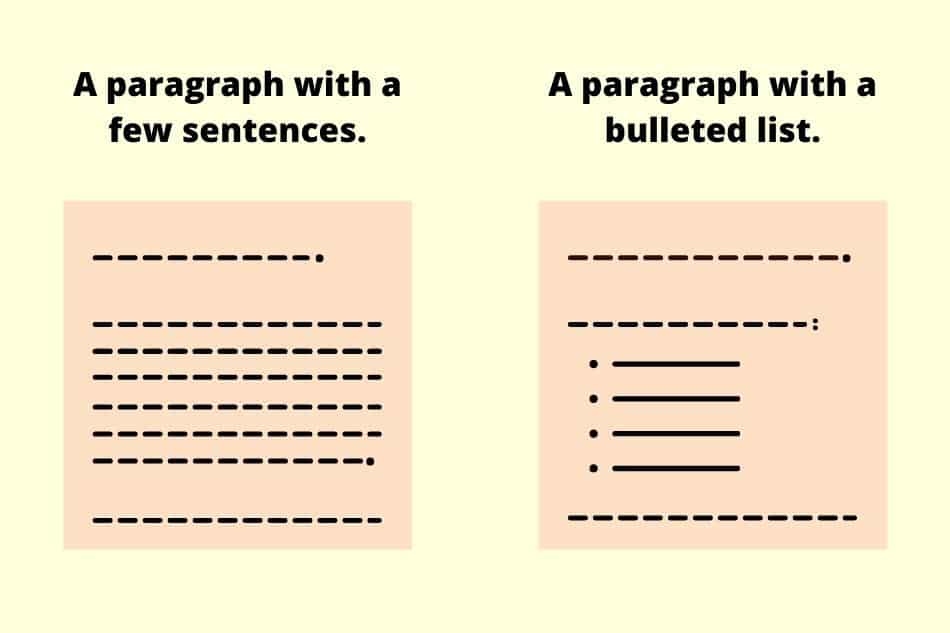
What Is the Purpose of an Ideal Paragraph?
The purpose of an ideal paragraph is to express an idea with proper supporting arguments with a concrete conclusion. However, it should always express one single idea clearly, specifically, and entirely with appropriate logic and illustrations.
While writing an essay or anything longer than that, the writer should ensure clarity and readability by guaranteeing the proper structure of the paragraph. Every paragraph should support the core idea of the essay.
The paragraphs themselves should individually reflect their ideas so clearly that the reader can find it quickly and return to that paragraph whenever they need to revisit the idea.
Purpose of Paragraphs in Long Piece of Writing
A long piece of writing that deals with a complex idea is usually difficult and tiresome for readers to interpret when reading at once. Readers need frequent intervals between thoughts or ideas when they process them simultaneously.
That is why it is the most important rule that a writer needs to deal with a single small idea in one paragraph.
The primary purpose of paragraphing in a long piece of writing is to break down a complex idea into several small ideas, each expressed in a slight stretch of text called a paragraph. It allows the readers to navigate easily from one idea to another without being confused or jumbled up.
Can a Single Sentence Make a Paragraph?
As a general rule, an ideal paragraph must have more than one sentence. However, it is seen that people also write single-sentence paragraphs. If only one sentence makes a paragraph, it has to be written in such a way that it includes a problem statement, supporting detail, and a link to the next paragraph.
You can write single-sentence paragraphs in informal online writing, such as blog posts. If you feel the idea will be well expressed if you keep it a single-sentence paragraph, you may do it. But if you do it too often, it may affect readability.
Make a Balance between Paragraphs’ Length in the Same Writing
It’s always important to keep a balance between the paragraphs in terms of length. It means there should not be a vast difference between the shortest and longest paragraphs in a single piece of writing.
No matter for what purpose you’re writing an essay or any more extended piece of writing, all your paragraphs should have an ideal length.
Let’s take an example. If you write a ten-sentence paragraph right after a single-sentence paragraph, you’ll surely end up making your reader frustrated about it. On the other hand, writing a five-sentence paragraph right after a three-sentence paragraph would be fine as it doesn’t make a huge difference in your reader’s expectations.
Importance of a Well-structured Paragraph
What you write is important, and how you present, it is equally important. That means the structure of any writing compliments the content and vice versa. For example, a well-structured paragraph can dramatically improve readability.
An ill-structured paragraph can have a severe impact on your writing. Every writer, regardless of genre, purpose, and platform, has the same purpose, and that’s to be read by others. Any writer’s ultimate and absolute goal is to engage their readers as much as possible.
A well-structured paragraph can help ease your effort of writing engaging content. Even average-quality writing can gain good engagement and reader base just because of a good structure.
In Conclusion
Nobody wants to read a too-long paragraph, no matter what reason they’re reading it. But wait! I hope now you know how long a paragraph is a too-long paragraph. You better remember one thing even if you forget everything.
You need to ask yourself while you write a long piece, “Would I be comfortable reading this paragraph, and is it easy to interpret and remember the information?” If the answer is yes, you’re good to go. If not, you would probably want to reorganize the sentences slightly to improve the paragraph.
Thanks for reading.
Happy learning!
(The author of this post is A H M Ohidujjaman, a C.I.T.E. certified tertiary-level English teacher with love for teaching English to ESL learners. He has done his Master’s in ELT, and taught thousands of ESL/EFL learners.)

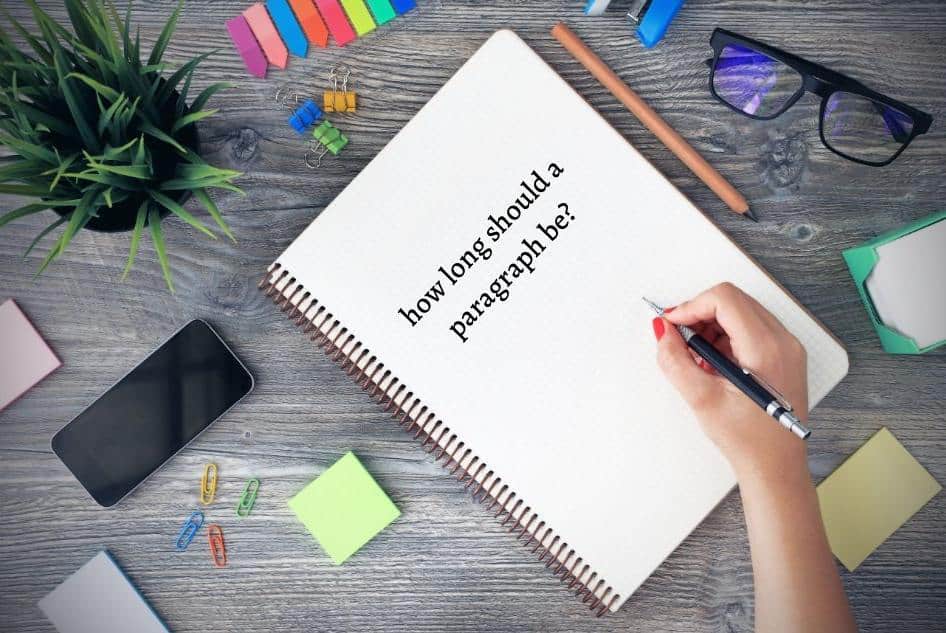
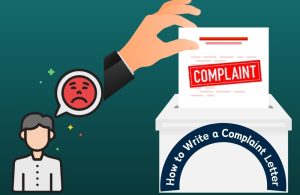

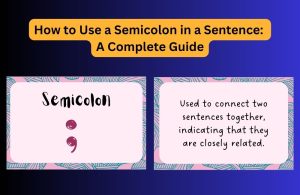
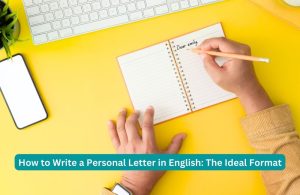
Thank you so much Sir. In this way, I can learn.
Thank you sir.